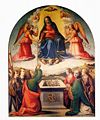Prato Cathedral
| Prato Cathedral Duomo di Prato; Cattedrale di Santo Stefano (in Italian) | |
|---|---|
Roman Catholic | |
| Province | Prato |
| Location | |
| Location | Prato, Italy |
| Geographic coordinates | 43°52′55″N 11°05′52″E / 43.88194°N 11.09778°E |
| Architecture | |
| Type | Church |
| Style | Romanesque |
| Groundbreaking | 1100 ca.[citation needed] |
| Completed | 1500 ca. |
Prato Cathedral, or Cathedral of Saint Stephen, (
It is one of the most ancient churches in the city, and was already in existence in the 10th century. It was built in several successive stages in the Romanesque style. The church contains a number of notable works of art, in particular fine sculpture.
History
The church of Saint Stephen was built in a green meadow (Prato) after an appearance of the

During the 14th century the cathedral acquired an important
In the early 15th century, a new façade or west front was added in the International Gothic style, in front of the old one. In the space between the two was created a narthex or corridor leading to the external pulpit, built by Michelozzo and decorated by Donatello between 1428 and 1438. The seven original reliefs of the parapet were removed from the pulpit in 1967 and can be seen today in Prato's cathedral museum.
The façade is architecturally simple, the shape of the building informing the new structure so that its low-pitched central roof and sloping side aisles mark the roofline, which is enlivened with an open parapet of simple Gothic tracery, uniting the building with the sky. The façade is divided into three sections by shallow buttresses or pilasters. That part above the springing of the door arch is faced with marble in bold contrasting stripes, while the lower part is pale-coloured but much stained in some areas, possibly from the absorption of pollutants.
The façade has a single central portal with a lintelled doorway surmounted by a Gothic arch. In the lunette over the door is a glazed terracotta sculpture by Andrea della Robbia depicting the Madonna with Saints Stephen and John.
Below the central gable, a decorative clock is set into the façade, in place of a central window. It is surrounded by segments of the contrasting marble and forms part of the harmonious design.
The frescoes of the transept chapel are also of the 15th century, but are in the Renaissance painting style.
Interior

Internally, the church, built on a
The north aisle houses a notable
-
Interior of church
-
Interior pulpit
-
Madonna of the Assumption by Ghirlandaio
-
Candelabra by Maso di Bartolomeo
Transept
A small staircase leads from the old church to the 14th-century transept, which has five high
In the south arm of the transept is the Renaissance tabernacle by the Da Maiano brothers: the Madonna with Child terracotta (1480) is by the more famous Benedetto.
The chapels can be accessed through a 17th-century
Transept chapels
In the south arm of the transept, the Vinaccesi Chapel houses a notable Deposition of Christ from the 13th century. It also has 19th-century frescoes by the Pratese painter Alessandro Franchi.

Next is the Assumption Chapel, which was frescoed in 1435-1436 by the so-called Master of Prato and by a young Paolo Uccello, who painted the Stories of the Virgin and St. Stephen, completed by Andrea di Giusto in the lower section. They show a bizarre fantasy of enchanted figures caught in a wide range of brilliant colors, and surrounded by Brunelleschi-like architectures.
In the main chapel, or
The Manassei Chapel was frescoed by a pupil of Agnolo Gaddi in the early 15th century with Stories of St Margaret and St James. The last chapel on the left, the Chapel of the Inghirami, houses a funerary monument attributed to Benedetto da Maiano and a stained glass window from the early 16th century.
-
Herod's Banquet by Lippi
-
Detail of Salome in Herod's Banquet
-
Frescoes by Lippi
-
ceiling frescoes by Paolo Uccello
Cintola Chapel
The Cintola Chapel (
The chapel has frescoes of Stories of the Virgin and the Cintola by Agnolo Gaddi (1392–1395), which are notable for their luminous colors. Also noteworthy is the panorama of Prato in the Michael's Return scene.
The 18th-century altar, which encloses the Cintola, is crowned by a marble Madonna with Child (c. 1301), and is considered one of Giovanni Pisano's masterpieces.
-
Madonna and Child by Giovanni Pisano
-
Monumental Gate by Maso di Bartolomeo,
-
Altar of the Cintola
-
Annuciation by Gaddi
-
History of the Cintola by Gaddi
Images
-
Bell tower
-
Chapel of the Blessed Sacrament - painting
-
Chapel of the Assumption by Paolo Uccello
-
Inside pulpit
-
Steps
-
Nave
-
Cloister
-
Company of Saint Stephen - underground chapel
External links
 Media related to Duomo (Prato) at Wikimedia Commons
Media related to Duomo (Prato) at Wikimedia Commons- Diocese of Prato - Cathedral page (in Italian)
- [1] (in Italian)
- [2] (in Italian)
- [3] (in Italian)

























